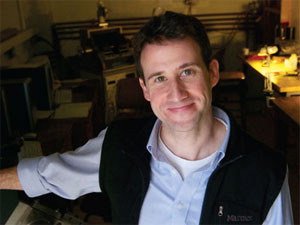Magnetic properties: Joshua Feinberg

It pulls the needle of a compass north, birds rely on it to migrate, honeybees orient themselves by it — and without it, life on Earth would be impossible.
Earth’s magnetic field is a force that guides life all around us, and McKnight Land-Grant professor Joshua Feinberg studies its behavior to determine what was happening millions of years ago.
“I use magnetic minerals to understand how rocks formed and how old archeological materials are,” he says.
Traces of the past
Magnetic minerals occur in all types of environments. They contain a precise record of how the magnetic field behaved up to 4.5 billion years ago.
The magnetization held by a rock sample can tell researchers how and when the material formed. The study of magnetic minerals has revealed how continents have drifted across the planet, how climate has shifted over millions of years, and how magma has risen underneath a volcano.
The information recorded by magnetic minerals in rocks in northern Minnesota may even tell us where we’re most likely to discover enriched deposits of copper.
Feinberg’s research team is also working with cave deposits to mark the changes in Earth’s magnetic field down to decadal timescales.
“As stalagmites grow, it’s almost like a series of tree rings that are forming. We can potentially get annual measurements of Earth’s magnetic field from these caves. For what my community does, that’s incredibly high resolution.”
The planet’s magnetic field is generated in the center of Earth, in its liquid iron core. Every so often, the convection cycles of the liquid iron will become destabilized and the north and south magnetic poles will reverse.
These reversals can be used as a way to determine the age of rocks. Knowing precisely when these “geomagnetic” reversals occurred is critical to understanding a huge array of geologic processes.
“There’s still a lot we don’t know about how reversals work and what the general behavior is of the magnetic field through time.”
Sampling the globe
As a specialist in rock magnetism and paleomagnetism, Feinberg has been called on by geologists from around the world to help study a variety of geological and archaeological research questions.
Using a modified chainsaw equipped with a diamond-tipped coring bit, he has sampled the rocks on nearly every continent, in countries including China, Italy, Mexico, Nepal and more.
Researchers bring these samples back to the University of Minnesota’s Institute for Rock Magnetism to learn how the magnetic field was oriented in the past, as well as how strong the field was at a given time.
What's next?
When asked about tools that will have a major impact on geology, Feinberg points to the following trends:
Rich data sets: In the past, it took scientists years of work just to obtain the data needed to solve a specific problem. But now, with satellite-generated data, geologists can get a much deeper data set more quickly, and use it in a more rigorous way than in the past.
Today, scientists can use satellite data to detect a change in the swelling of a volcano, down to the centimeter. Satellite measurements of Earth’s magnetic field, as well as the magnetic fields of distant planets and asteroids, will enable us to address a new range of scientific questions for the first time.
SWARM changes everything: Later this year, the European Space Agency will launch SWARM, a highly sophisticated satellite constellation that will give researchers the most detailed view of Earth’s magnetic field ever.
This new data will enable researchers to explore the structure of the planet in a level of detail that’s been impossible until now.
Republished with permission from Research @ the U of M, a publication of the Office of the Vice President for Research.
